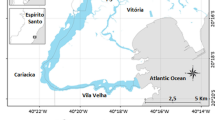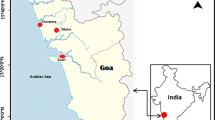Abstract
Background, aim, and scope
Exceptionally high levels of trace metals have been reported in specific tissues of certain polychaetes. In the present study, the Antarctic fan worm Perkinsiana littoralis was shown to hyperaccumulate vanadium in the branchial tissues, and the hypothesis of an antipredatory strategy has been investigated
Materials and methods
Trace metals (Ag, Al, As, Ba, Cd, Co, Cr, Cu, Fe, Hg, Mn, Ni, Pb, Se, V, Zn) were measured by atomic absorption spectrophotometry in tissues of P. littoralis and, only for V, in two Antarctic bivalves and in various Mediterranean polychaetes. Subcellular distribution of vanadium was investigated in P. littoralis after differential centrifugations; feeding trials with the Antarctic rock cod Trematomus berancchii were performed to test the palatability of P. littoralis
Results and discussion
Analyses of trace metals in tissues of P. littoralis confirmed the naturally high bioavailability of cadmium due to upwelling phenomena in the investigated area and revealed extremely high concentrations of vanadium up to 10,000 µg/g, in the branchial crowns; much lower concentrations were measured in the body portions and even less in the Antarctic bivalves and in Mediterranean polychaetes. The subcellular distribution indicated that this metal was associated in branchial crowns with both heavy components and vanadium binding proteins; the latter predominated in body tissues, although with a different pattern of molecular weight. Feeding trials suggested that the elevated levels of vanadium in branchial crown of P. littoralis act as chemical deterrents against predation in more exposed tissues
Recommendations and perspectives
The hyperaccumulation of toxic metals might represent a common antipredatory strategy for unpalatable branchial crowns of sabellid polychaetes, as recently hypothesized also for the high concentrations of arsenic in the Mediterranean Sabella spallanzanii. The evolution of such adaptation and the reasons behind the possibility for different species to accumulate different metals represent a stimulating field of investigation for future studies.


Similar content being viewed by others
References
Al-Mohanna SY, Subrahmanyam MNV (2001) Flux of heavy metal accumulation in various organs of the intertidal marine blue crab, Potunus pelagicus (L.) from the Kuwait coast after the Gulf War. Environ Int 27:321–326. doi:10.1016/S0160-4120(01)00063-0
Amiard J-C, Journel R, Bacheley H (2008) Influence of field and experimental exposure of mussels (Mytilus sp.) to nickel and vanadium on metallothionein concentration. Comp Biochem Physiol C 147:378–385. doi:10.1016/j.cbpc.2008.01.006
Athalye RP, Gokhale KS (1991) Heavy metals in the polychaete Lycastis ouanaryensis from Thane Creek. India Mar Pollut Bull 22:233–236. doi:10.1016/0025-326X(91)90916-G
Avila C, Taboada S, Nuñez-Pons L (2008) Antarctic marine chemical ecology: what is next? Mar Ecol 29:1–71. doi:10.1111/j.1439-0485.2007.00215.x
Bargagli R (2005) Antarctic ecosystems. Environmental contamination, climate change and human impact. Springer, Berlin
Barsby T, Kicklighter CE, Hay ME, Sullards MC, Kubanek J (2003) Defensive 2-alkylpyrrole sulfamates from the marine annelid Cirriformia tentaculata. J Nat Prod 66:1110–1112. doi:10.1021/np030149z
Bocchetti R, Fattorini D, Gambi MC, Regoli F (2004) Trace metal concentrations and susceptibility to oxidative stress in the Polychaete Sabella spallanzanii (Gmelin) (Sabellidae): potential role of antioxidants in revealing stressful environmental conditions in the Mediterranean. Arch Environ Contam Toxicol 46:353–361. doi:10.1007/s00244-003-2300-x
Cheggour M, Texier H, Moguedet G, Elkaim B (1990) Metal exchanges in the fauna–sediment system. The case of Nereis diversicolor and Scrobicularia plana in the Bou Regreg estuary (Morocco). Hydrobiologia 207:209–219. doi:10.1007/BF00041458
Clarke A, Johnston NM (2003) Antarctic marine benthic diversity. Oceanograph Mar Biol Ann Rev 41:47–114
Cole AG, Hall BK (2004) The nature and significance of invertebrate cartilages revisited: distribution and histology of cartilage and cartilage-like tissues within the Metazoa. Zoology 107:261–273. doi:10.1016/j.zool.2004.05.001
Edel J, Sabbioni E (1993) Accumulation, distribution and form of vanadate in the tissues and organelles of the mussel Mytilus edulis and the goldfish Crassius auratus. Sci Total Environ 133:139–151. doi:10.1016/0048-9697(93)90118-P
Fattorini D, Notti A, Di Mento R, Cicero AM, Gabellini M, Russo A, Regoli F (2008) Seasonal, spatial and inter-annual variations of trace metals in mussels from the Adriatic Sea: a regional gradient for arsenic and implications for monitoring the impact of off-shore activities. Chemosphere 72:1524–1533. doi:10.1016/j.chemosphere.2008.04.071
Fattorini D, Notti A, Halt MN, Gambi MC, Regoli F (2005) Levels and chemical speciation of arsenic in polychaetes: a review. Mar Ecol 26:255–264. doi:10.1111/j.1439-0485.2005.00057.x
Fattorini D, Regoli F (2004) Arsenic speciation in tissues of the Mediterranean polychaete Sabella spallanzanii. Environ Toxicol Chem 23:1881–1887. doi:10.1897/03-562
Gibbs PE, Bryan GW, Ryan KP (1981) Copper accumulation by the polychaete Melinna palmata: an antipredation mechanism? J Mar Biol Ass UK 61(3):707–722. doi:10.1017/S0025315400048153
Goerke H, Emrich R, Weber K, Duchene JC (1991) Concentrations and localization of brominated metabolites in the genus Thelepus (Polychaeta, Terebellidae). Comp Biochem Physiol B 99:203–206. doi:10.1016/0305-0491(91)90030-H
Grotti M, Soggia F, Lagomarsino C, Dalla Riva S, Goessler W, Francesconi KA (2008) Natural variability and distribution of trace elements in marine organisms from Antarctic coastal environments. Antarctic Sci 20:39–52. doi:10.1017/S0954102007000831
Ishii T, Otake T, Okoshi K, Nakahara M, Nakamura R (1994) Intracellular localization of vanadium in the fan worm Pseudopotamilla occelata. Mar Biol 121:143–151. doi:10.1007/BF00349483
Kanda T, Nose Y, Wuchiyama J, Uyama T, Moriyama Y, Michibata H (1997) Identification of a vanadium-associated protein from the vanadium-rich ascidian, Ascidia sydneiensis samea. Zool Sci 14:37–42. doi:10.2108/zsj.14.37
Kawakami N, Ueki T, Amata Y, Kanamori K, Matsuo K, Gekko K, Michibata H (2009) A novel vanadium reductase, Vanabin2, forms a possible cascade involved in electron transfer. Biochim Biophys Acta 1794:674–679. doi:10.1016/j.bbapap. 2009.01.007
Kicklighter CE, Hay ME (2006) Integrating prey defensive traits: contrasts of marine worms from temperate and tropical habitats. Ecol Monogr 76:195–215. doi:10.1890/0012-9615(2006)076[0195:IPDTCO]2.0.CO;2
Kicklighter CE, Hay ME (2007) To avoid or deter: interactions among defensive and escape strategies in sabellid worms. Oecologia 151:161–173. doi:10.1007/s00442-006-0567-0
La Mesa M, Dalù M, Vacchi M (2004) Trophic ecology of the emerald notothen Trematomus bernacchii (Pisces, Nototheniidae) from Terra Nova Bay, Ross Sea. Antarctica Polar Biol 27:721–728. doi:10.1007/s00300-004-0645-x
Lavilla I, Vilas P, Millos J, Bendicho C (2006) Development of an ultrasound-assisted extraction method for biomonitoring of vanadium and nickel in the coastal environment under the influence of the Prestige fuel spill (North east Atlantic Ocean). Anal Chim Acta 577:119–125. doi:10.1016/j.aca.2006.06.021
Lichtenegger HC, Schöberl T, Bartl MH, Waite H, Stucky GD (2002) High abrasion resistance with sparse mineralization: copper biomineral in worm jaws. Science 298:389–392. doi:10.1126/science.1075433
McClintock JB, Baker BJ (1997) A review of the chemical ecology of Antarctic marine invertebrates. American Zool 37:329–342. doi:10.1093/icb/37.4.329
McClintock JB, Baker BJ (2001) Marine chemical ecology. CRC Marine Science Series, Boca Raton
Méndez N, Pàez-Osuna F (1998) Trace metals in two populations of the fireworm Eurithoe complanata from Mazatlàn Bay: effect of body size on concentrations. Environ Poll 102:279–285. doi:10.1016/S0269-7491(98)00061-X
Michibata H, Uyama T, Ueki T, Kanamori K (2002) Vanadocytes, cells hold the key to resolving the highly selective accumulation and reduction of vanadium in ascidians. Micros Res Tech 56:421–434. doi:10.1002/jemt.10042
Minganti V, Capelli R, De Pellegrini R (1998) The concentrations of Pb, Cd, Cu, Zn and V in Adamussium colbecki from Terra Nova Bay (Antartica). Int J Environ Anal Chem 71:257–263. doi:10.1080/03067319808032631
Nejmeddine A, Dhainaut-Courtois N, Baert JL, Sautière P, Fournet B, Boulenguer P (1988) Purification and characterization of a cadmium-binding protein from Nereis diversicolor (Annelida, Polychaeta). Comp Biochem Physiol C 89:321–326. doi:10.1016/0742-8413(88)90231-9
Notti A, Fattorini D, Razzetti EM, Regoli F (2007) Bioaccumulation and biotransformation of arsenic in the Mediterranean polychaete Sabella spallanzanii: experimental observations. Environ Toxicol Chem 26:1186–1191. doi:10.1897/06-362R.1
Odate S, Pawlik JR (2007) The role of vanadium in the chemical defences of the solitary tunicate, Phallusia nigra. J Chem Ecol 33:643–654. doi:10.1007/s10886-007-9251-z
Paul VJ, Puglisi MP, Ritson-Williams R (2006) Marine chemical ecology. Nat Prod Rep 23(2):153–180. doi:10.1039/b404735b
Pawlik JR (1993) Marine invertebrate chemical defences. Chem Rev 93:1911–1922. doi:10.1021/cr00021a012
Pawlik JR, Chanas B, Toonen RJ, Fenical W (1995) Defenses of Caribbean sponges against predatory reef fish I. Chemical deterrency. Mar Ecol Prog Ser 127:183–194. doi:10.3354/meps127183
Popham JD, D’Auria JM (1982) A new sentinel organism for vanadium and titanium. Mar Pollut Bull 13(1):25–27. doi:10.1016/0025-326X(82)90493-3
Rainbow PS (2007) Trace metal bioaccumulation: models, metabolic availability and toxicity. Environ Int 33:576–582. doi:10.1016/j.envint.2006.05.007
Regoli F, Nigro M, Benedetti M, Gorbi S, Pretti C, Gervasi PG, Fattorini D (2005) Interactions between metabolism of trace metals and xenobiotics agonists of the Ah receptor in the Antarctic fish Trematomus bernacchii: environmental perspectives. Environ Toxicol Chem 24(6):1475–1482. doi:10.1897/04-514R.1
Sandrini JZ, Regoli F, Fattorini D, Notti A, Ferreira Inàcio A, Linde-arias AR, Laurino J, Bainy ACD, Fernandes Marins LF, Monserrat JM (2006) Short-term responses to cadmium exposure in the estuarine polychaete Laeonereis acuta (Polychaeta, Nereididae): subcellular distribution and oxidative stress generation. Environ Toxicol Chem 25(5):1337–1344. doi:10.1897/05-275R.1
Sperling KR, Bahr B, Ott J (2000) Vanadium in marine mussels and algae. Fresenius' J Anal Chem 366:132–136. doi:10.1007/s002160050024
Ueki T, Adachi T, Kawano S, Aoshima M, Yamaguchi N, Kanamori K, Michibata H (2003) Vanadium-binding proteins (vanabins) from a vanadium-rich ascidian Ascidia sydneiensis samea. Biochim Biophys Acta 1626:43–50. doi:10.1016/S0167-4781(03)00036-8
Uyama T, Nose Y, Wuchiyama J, Moriyama Y, Michibata H (1997) Finding of the same antigens in the polychaete, Pseudopotamilla occelata, as those in the vanadium-rich ascidian, Ascidia sydneiensis samea. Zool Sci 14:43–47. doi:10.2108/zsj.14.43
Yoshihara M, Ueki T, Yamaguchi N, Kamino K, Michibata H (2008) Characterization of a novel vanadium-binding protein (VBP-129) from blood plasma of vanadium-rich ascidian Ascidia sydneiensis samea. Biochim Biophys Acta 1780:256–263. doi:10.1016/j.bbagen.2007.11.001
Author information
Authors and Affiliations
Corresponding author
Additional information
Responsible editor: Alvin Lee Young
Rights and permissions
About this article
Cite this article
Fattorini, D., Notti, A., Nigro, M. et al. Hyperaccumulation of vanadium in the Antarctic polychaete Perkinsiana littoralis as a natural chemical defense against predation. Environ Sci Pollut Res 17, 220–228 (2010). https://doi.org/10.1007/s11356-009-0243-0
Received:
Accepted:
Published:
Issue Date:
DOI: https://doi.org/10.1007/s11356-009-0243-0




